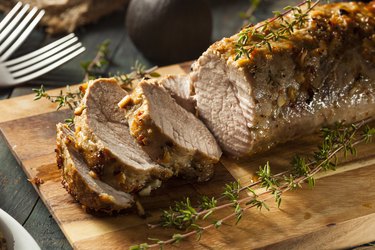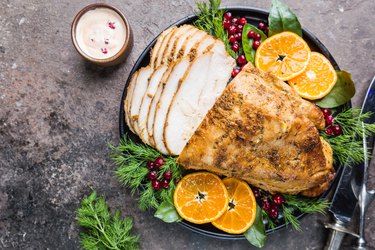
When it comes to losing weight, getting a handle on how many calories you're eating is important, but so is making sure you're getting an appropriate balance of carbs, fat and protein.
The latter is one reason why meat can support your weight-loss goals — it's a stellar source of protein. This macronutrient is important when you're looking to shed fat because it helps maintain your lean muscle mass, according to a March 2020 study in The Journal of Nutrition. Your muscle tissue is more metabolically active than your fat stores, so maintaining lean muscle mass while losing weight will help keep your resting metabolic rate up (aka help you burn more calories).
Video of the Day
Video of the Day
Also, compared to the other two macros — fat and carbs — protein is the most satiating, according to an April 2015 American Journal of Clinical Nutrition article.
There are different ways to meet your protein needs — you don't have to rely on meat. Healthy plant-based protein sources include tofu, tempeh, beans, nuts, seeds and even whole grains.
That said, if you're partial to meat, some options are better for weight loss than others.
Tip
If you're losing weight, you should aim for 1.3 grams of protein per kilogram of body weight each day (keeping in mind that a kilogram equals 2.2 pounds), according to a December 2019 Advances in Nutrition review. For a 200-pound person, that's about 118 grams.
5 Meats to Eat When You're Trying to Lose Weight

1. Lean Beef
Red meat contains saturated fat, but there are leaner cuts you can enjoy in moderation, including sirloin steak, tenderloin and lean ground beef. For example, a 3-ounce cooked portion of 95-percent lean ground beef has 150 calories and 23 grams of protein, per the USDA.
So what does "in moderation" mean? For cancer prevention, The World Cancer Research Fund recommends limiting yourself to three portions a week (reminder: one portion is about 3 ounces, cooked). On average, we currently eat just over this at 3.5 ounces per day, according to the American Heart Association.
2. Skinless Chicken
Skinless chicken breast can be one of the leanest sources of protein. The key is choosing white meat (over dark), which you can find in the breast, tenders and wings.
A 3-ounce serving of cooked chicken breast has 135 calories and 28 grams of protein, per the USDA. It also has ample amounts of phosphorus, selenium, riboflavin, niacin, vitamin B6 and choline.
Remember, remove the skin before eating and avoid dark meat, which you'll find in the thigh or drumstick.
Related Reading
3. Mollusks
Seafood and fish can be a nutrient-rich source of protein but you'll want to be cautious of healthier options that are low in mercury and are sustainable for our planet.
Clams, mussels and oysters are excellent choices because they're typically low in mercury, according to the Environmental Defense Fund. What's unique about mollusks is that they're especially good for our waters because they help keep it clean by filtering out heavy metals and other biological matter. When farm-raised on ropes, they don't require feed and the harvesting process has minimal strain on the environment.
A 3-ounce serving of mussels provides 146 calories and 20 grams of protein, per the USDA.
4. Lean Pork
Like most meats, there are healthier cuts of pork like pork chops, tenderloin and sirloin pork roast and there are those that are much fattier, like bacon and pork belly. For instance, a 3-ounce serving of pork tenderloin has 122 calories and 22 grams of protein, according to the USDA.
Tip
When shopping for leaner cuts, look for “loin” or “chop” in the name.
When cooking pork, cut away any visible fat and always reach an internal temperature of 145 degrees when cooking, per the Food and Drug Administration guidelines.
5. White Turkey Meat
Like chicken, white turkey meat is another source of lean poultry. You'll find the white meat in the breast and wing, while dark meat is found in the leg.
White meat is lower in calories but when eating a 3-ounce portion, the differences are negligible. The amount of protein and total fat are the differentiating factors.
For instance, roasted turkey breast has 125 calories, 2 grams of fat, 0.5 grams of saturated fat and 25 grams of protein, while dark roasted turkey meat provides 130 calories, 9 grams of fat, 2 grams of saturated fat and 13 grams of protein, per the USDA.
Healthy Tips for Eating Meat
- Like all things, everything in moderation — keep portions in check. The American Heart Association recommends limiting meat intake (ideally nonfried fish, shellfish, poultry without skin and trimmed lean meats) to 5.5 ounces, cooked, per day.
- Enjoy red meat but limit your quantity. One portion is 3 ounces, or about the size of a deck of cards.
- When choosing red meat, choose leaner types and trim any excess fat.
- When it comes to fish, eat up to 8 ounces per week, especially oily fish like salmon and herring.
- Use better-for-you cooking methods like baking, roasting, broiling, stewing, boiling or roasting rather than frying or grilling.
3 Types of Meat to Limit or Avoid

1. Fried Meats
Even if you take healthier meats like chicken, coating them with breading and deep frying negates any health benefits you may be seeking. For starters, it dramatically increases the calorie and fat content. Case in point: A 3-ounce serving of fried chicken tenders has 250 calories, 13 grams of fat and 15 grams of protein, compared to the same serving of chicken breast, which has 135 calories, 3 grams of fat and 28 grams of protein, according to the USDA.
This may help explain why in a February 2013 Nutrition, Metabolism and Cardiovascular Disease study, researchers found that eating fried foods more than four times a week significantly increased the risk for becoming overweight or obese compared to limiting fried food to less than twice a week.
2. Processed Red Meats
Bacon, hot dogs, beef jerky, salami and sausages are all prime examples of processed red meats. They're higher in calories, saturated fat and sodium, compared to leaner, less-processed cuts of red meat, according to the American Heart Association (AHA), which makes them bad for our hearts.
A 3-ounce lean beef patty has 120 calories, 3 grams of fat, 1 gram of saturated fat and 22 grams of protein, while the same portion of bacon has 400 calories, 30 grams of fat and 10 grams of protein.
Research shows that cutting down on processed meat —even by just 2 percent of your total calories — and replacing with plant protein is linked to a 32 percent lower risk of death, according to the AHA.
3. Fish High in Mercury
While fish and seafood can be excellent sources of protein and important vitamins and minerals, they can also be high in mercury. To limit or reduce your exposure, avoid tilefish, swordfish, king mackerel, ahi tuna, bigeye tuna and orange roughy, as listed by the Natural Resources of Defense Council.
You also need to be cautious when it comes to canned tuna. Skipjack or light tuna are safer options. Albacore tuna is higher in mercury and should be limited.
- The Journal of Nutrition: "High Compared with Moderate Protein Intake Reduces Adaptive Thermogenesis and Induces a Negative Energy Balance during Long-term Weight-Loss Maintenance in Participants with Prediabetes in the Postobese State: A PREVIEW Study"
- American Journal of Clinical Nutrition: "The Role of Protein in Weight Loss and Maintenance"
- American Heart Association: "Meat, Poultry, and Fish: Picking Healthy Proteins"
- MyFoodData: "Beef Ground 95% Lean Meat / 5% Fat Loaf Cooked Baked"
- The World Cancer Research Fund: "Limit Red and Processed Meat"
- MyFoodData: "Lean Chicken Breast (Cooked)"
- Environmental Defense Fund: "Eco-friendly Best Choices"
- MyFoodData: "Roasted Pork Tenderloin"
- Food and Drug Administration: "Safe Minimum Cooking Temperatures Charts"
- MyFoodData: "Nutrition Facts Comparison Tool"
- MyFoodData: "Cracker Barrel Chicken Tenderloin Platter Fried"
- Nutrition, Metabolism and Cardiovascular Disease: "Consumption of Fried Foods and Weight Gain in a Mediterranean Cohort: The SUN Project"
- Natural Resources of Defense Council: "Mercury Guide"
- Advances in Nutrition: "Protein Intake Greater than the RDA Differentially Influences Whole-Body Lean Mass Responses to Purposeful Catabolic and Anabolic Stressors: A Systematic Review and Meta-analysis"
- American Heart Association: "Can Processed Foods Be Part of a Healthy Diet"